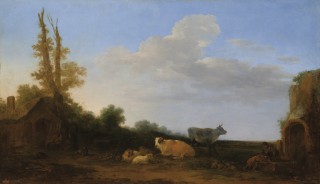Landscape with Cows, Sheep, a Hut and Ruins
- Date
- after 1769
- Object type
- painting
- Technique
- oil
- Material
- canvas
- Dimensions
- 77,5 x 133,0 cm
- Acquisition date
- 1788
- Location
- The Palace on the Isle - Portrait Room, ground floor
- Marks and inscriptions
- red number 1608 of the Stanisław August collection, bottom left
- Place of Origin
- Paris (France)
- Owner
- The Royal Łazienki
- Museum number
- ŁKr 824
.... The painting has the same dimensions and a similar composition to Landscape with a White Horse and a Stormy Sky (cat. no. 29): it shows a vast, flat landscape viewed from a low angle, with the outlines of animals in the foreground against a large expanse of sky. The paintings could be pendants depicting two different times of the day, or two different types of weather: an overcast evening in Landscape with a White Horse and a sunny morning in Landscape with Cows. We do not know whether they were conceived as companion pieces, or whether they simply testify to the artist’s use of similar compositional solutions.
In Landscape with Cows, Sheep, Hut and Ruins Casanova—who was taught in Venice—enriched his Dutch Italianate formula with a treatment typical of 18th-century Venetian capriccio or vedute ideate. He combined in one view two elements which in reality could not possibly co-exist: a typical Dutch wooden hut, almost like in Jan van Goyen’s paintings, and the ruins of a building covered with vegetation, which seem to come straight out of the Roman Campagna. ... A clear indication of Casanova’s Venetian education is also his tòcco: light, fluid, and spontaneous. ... . [See D. Juszczak, H. Małachowicz, The Stanisław August Collection of Paintings at the Royal Łazienki. Catalogue, Royal Łazienki Museum, Warsaw 2016, no. 28, p. 131.]







